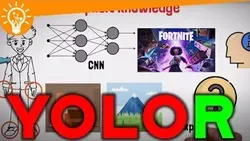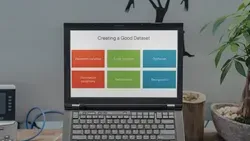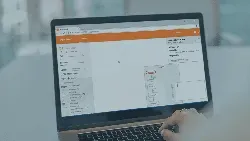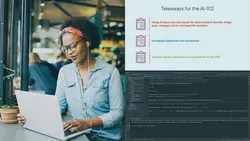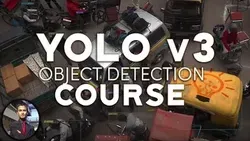
YOLO v3 - Robust Deep Learning Object Detection Tutorials

This course provides an introduction to Yolo V3 Object Detection, a robust deep learning technique for detecting objects in images. It covers topics such as how to implement Yolo V3 on Windows with GPU, what YOLO Object Detection is, and how to web scrape images for training. Additionally, it covers how to use Yolo V3 for object detection in videos, and how to use Yolo V3 with Darknet. The course provides a comprehensive overview of Yolo V3 Object Detection.▼
Course Feature
![]() Cost:
Cost:
Free
![]() Provider:
Provider:
Youtube
![]() Certificate:
Certificate:
Paid Certification
![]() Language:
Language:
English
![]() Start Date:
Start Date:
On-Demand
Course Overview
❗The content presented here is sourced directly from Youtube platform. For comprehensive course details, including enrollment information, simply click on the 'Go to class' link on our website.
Updated in [February 21st, 2023]
What does this course tell?
(Please note that the following overview content is from the original platform)
Introduction to Yolo V3 Object Detection - FULL COURSE.
Yolo v3 Object Detection - How to Implement Yolo V3 Object Detection on Windows with GPU | Tut #1.
What is YOLO Object Detection?.
Yolov3 Object Detection Tutorial #3 - Web Scrape Images | OpenCV Python | Computer Vision 2020.
Yolo v3 Tutorial #4 - Object Detection Training Part 3 - Super Quick Dataset Annotation.
Yolo v3 Object Detection Tutorial #5 - Object Detection Training Pt4.
Yolov3 Object Detection Tutorial #6 - Deploying Your Model | OpenCV Python | Computer Vision 2020.
Yolov3 Object Detection Tutorial #2 - Training Part 1 | OpenCV Python | Computer Vision 2020.
How to Be an AI Practitioner in 2019/2020 - 5 Step AI in Computer Vision Workflow.
7 Frequently Asked Questions on AI in Computer Vision.
Trailer - 10 Tips to becoming a PRO Practitioner in AI-CV (AI in Computer Vision) Webinar.
We consider the value of this course from multiple aspects, and finally summarize it for you from three aspects: personal skills, career development, and further study:
(Kindly be aware that our content is optimized by AI tools while also undergoing moderation carefully from our editorial staff.)
This course provides an introduction to YOLO v3, a robust deep learning object detection system. It covers topics such as how to implement YOLO v3 on Windows with GPU, what YOLO object detection is, how to train and deploy a model, and how to become an AI practitioner in 2019/2020.
Possible development paths for learners include becoming an AI practitioner in computer vision, learning how to implement YOLO v3 on Windows with GPU, and understanding the 5-step AI in computer vision workflow. Learners can also explore topics such as web scraping images, dataset annotation, and object detection training.
Learning suggestions for learners include exploring related topics such as AI in computer vision, deep learning, and object detection. Learners can also watch the 10 Tips to becoming a PRO Practitioner in AI-CV webinar and read the 7 Frequently Asked Questions on AI in Computer Vision. Additionally, learners can practice their skills by training and deploying their own models.
[Applications]
After completing this course, learners can apply their knowledge of YOLO v3 to develop robust deep learning object detection models. They can use the techniques learned in the tutorials to create their own object detection models and deploy them in real-world applications. Learners can also use the tips and tricks shared in the course to become a PRO practitioner in AI-CV (AI in Computer Vision).
[Career Paths]
1. AI Practitioner: AI Practitioners are responsible for developing and deploying AI-based solutions to solve real-world problems. They must have a deep understanding of the underlying algorithms and technologies, as well as the ability to apply them to solve complex problems. Developing trends in this field include the use of deep learning and reinforcement learning to create more powerful AI solutions.
2. Computer Vision Engineer: Computer Vision Engineers are responsible for developing and deploying computer vision algorithms and systems. They must have a deep understanding of the underlying algorithms and technologies, as well as the ability to apply them to solve complex problems. Developing trends in this field include the use of deep learning and reinforcement learning to create more powerful computer vision systems.
3. Machine Learning Engineer: Machine Learning Engineers are responsible for developing and deploying machine learning algorithms and systems. They must have a deep understanding of the underlying algorithms and technologies, as well as the ability to apply them to solve complex problems. Developing trends in this field include the use of deep learning and reinforcement learning to create more powerful machine learning systems.
4. Data Scientist: Data Scientists are responsible for analyzing and interpreting large datasets to uncover insights and trends. They must have a deep understanding of the underlying algorithms and technologies, as well as the ability to apply them to solve complex problems. Developing trends in this field include the use of deep learning and reinforcement learning to create more powerful data analysis solutions.
Course Provider


